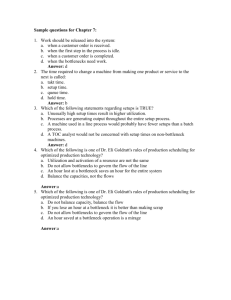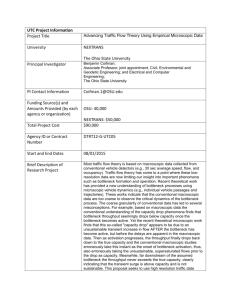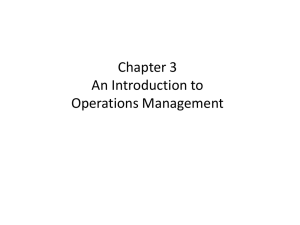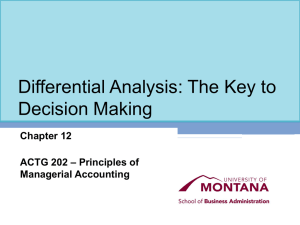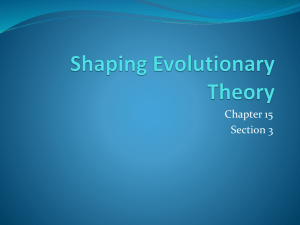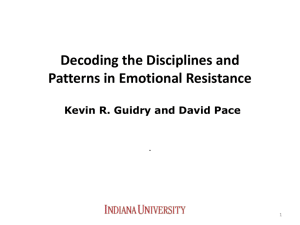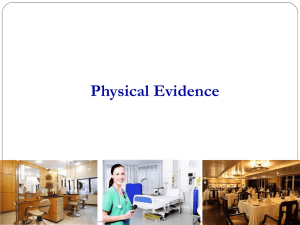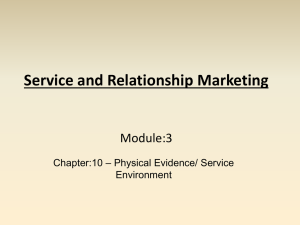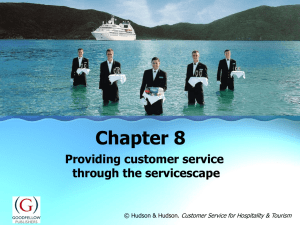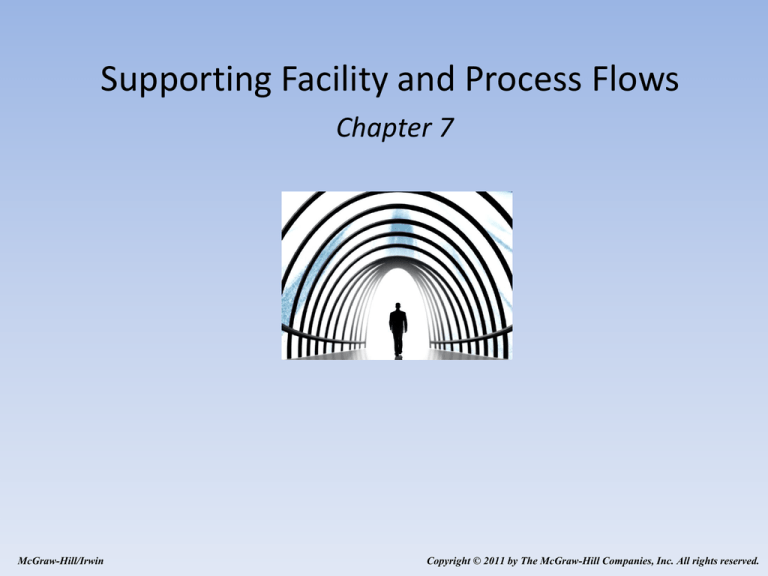
Supporting Facility and Process Flows
Chapter 7
McGraw-Hill/Irwin
Copyright © 2011 by The McGraw-Hill Companies, Inc. All rights reserved.
Course Overview
Define, describe and classify services (Ch 1,2)
SPECIAL TOPICS
VIEWS
TOOLS
Information
technology (Ch 5)
Strategic view of
service design &
development (Ch 3,4)
Capacity planning &
queuing models
(Ch 11,12,16)
Supply Chains &
Outsourcing (Ch 13)
Process view of
quality improvement
(Ch 6,7,8)
Project management
(Ch 15)
Facility location
(Ch 10)
Globalization (Ch 14)
Encounter view of
customers &
employees (Ch 9)
Inventory control
(Ch 18)
2
Servicescapes
Designing Physical Surroundings to Affect Employee
and Customer Behavior
• Ambient Conditions: background characteristics
such as noise level, music, lighting, temperature, and
scent.
• Spatial Layout and Functionality: reception area,
circulation paths of employees and customers, and
focal points.
• Signs, Symbols, and Artifacts: selection, orientation,
location, and size of objects.
3
Environmental Orientation Considerations
• Need for spatial cues to orient visitors
• Formula facilities draw on previous experience
• Entrance atrium allows visitors to gain a quick
orientation and observe others for behavioral cues
• Orientation aids and signage such as “You Are Here”
maps reduce anxiety
• Allow customers to see both into and through the
space
4
Facility Design Considerations
• Nature and Objectives of Service
Organization
• Land Availability and Space
Requirements
• Flexibility
• Security
• Aesthetic Factors
• The Community and Environment
5
Types of Services Processes
Process Type
Service
Example
Characteristic
Management Challenge
Project
Consulting
One-of-a-kind engagement
Staffing and scheduling
Job Shop
Hospital
Many specialized departments
Balancing utilization and
scheduling patients
Batch
Airline
Group of customers treated
simultaneously
Pricing of perishable
asset (seat inventory)
Flow
Cafeteria
Fixed sequence of operations
Adjust staffing to demand
fluctuations
Continuous
Electric Utility
Uninterrupted delivery
Maintenance and
capacity planning
6
Process Flow Diagrams
• Visualize and document a process
• Identify bottlenecks
• Determine system capacity
• Make improvements
7
Process Flow Diagram of Mortgage Service
Property Survey
CT=90 min.
Completed
Applications
Mortgage
Applications
Yes
Final Approval
Approved
Mortgages
CT=15 min.
No
Accept
Mortgages
Credit Report
Title Search
CT=45 min.
CT=30 min.
Unapproved
Mortgages
Finish
Processing
8
Mortgage Service Process Gantt Chart
Rush Order Flow Time =
90 + 15 = 105 min
3
1
2
Process Cycle Time
Every 90 min a new
mortgage is completed
Slide contributed by David Hoyte
Fig. 7.5, pg 163
9
Process Analysis Terminology
• Cycle Time is the average time between completions
of successive units.
• Bottleneck is the factor that limits production usually
the slowest operation.
• Capacity is a measure of output per unit time when
fully busy.
• Capacity Utilization is a measure of how much output
is actually achieved.
• Throughput Time is the time to complete a process
from time of arrival to time of exit.
10
Process Analysis Terminology (cont.)
• Rush Order Flow Time is the time to go through the
system without any queue time.
• Direct Labor Content is the actual amount of work
time consumed.
• Total Direct Labor Content is the sum of all the
operations times.
• Direct Labor Utilization is a measure of the
percentage of time that workers are actually
contributing value to the service.
11
Bottlenecks
1) When flow is not
synchronized, process
rate is limited by the
“bottleneck”
2) The bottleneck
constrains throughput.
The rate of total
throughput is the rate of
the bottleneck
3) Time lost on the
bottleneck is time lost in
the whole process
Slide contributed by David Hoyte
12
Work Allocation – Boat Show
2
1
In
30
120
Collect
Payment
15
240
Hand Stamp
+ program
What is the Process Capacity?
Where is the Bottleneck?
What if 1 more person is added?
3
15
Out
240
Apply wrist
band
Capacity Calculation:
15 sec cycle = 4
customers per min
= 4 x 60 = 240
customers per hour
Activity
Number(s)
Capacity
per hour
Cycle Time
in seconds
Slide contributed by David Hoyte
13
Work Allocation – Boat Show
1
In
30
2
15
1
In
120
30
240
3
15
240
Out
120
Collect
Payment
Hand Stamp
+ program
Apply wrist
band
What is the Process Capacity now?
Slide contributed by David Hoyte
14
Options for Eliminating a Bottleneck
1. Add another worker to the job.
2. Provide aid to reduce activity time.
(e.g. automating an activity)
3. Regroup the tasks to create a new line balance
with different activity assignments.
• Goal: all jobs/activities should be of nearly
equal duration.
15
Automobile Driver’s License Office
2
1
15
In
240
Review
30
120
Payment
4
3
60
60
Violations
40
90
Eye Test
Activity
Number(s)
Cycle Time
in seconds
5
20
180
Photograph
6
30
120
Issue
Out
Capacity
per hour
16
Automobile Driver’s License Office
(Improved Layout)
In
1,4
55
65
3
60
60
2
30
In
1,4
55
65
3
60
120
5
20
180
Out
6
30
120
60
17
Health Maintenance Organization (B)
Activity
Time (sec.)
Receive prescriptions
24
Type labels
120
Fill prescriptions *
60
Check prescriptions *
40
Dispense prescriptions *
30
* Must be performed by Pharmacist
18
HMO (B) Questions
1. Identify the bottleneck activity, and show how
capacity can be increased by using only two
pharmacists and two technicians.
2. In addition to savings on personnel costs, what
benefits does this arrangement have?
19
HMO (B) Process Flow
Current staffing: 2 Techs & 3 Pharmacists,
each doing one task
Activity
1
2
3
150
24
Cycle
time
4
30
120
5
60
60
90
40
120
30
Capacity
per hour
What is the bottleneck operation?
What is the capacity of the system?
Why? How can capacity be increased?
Slide contributed by David Hoyte
20
HMO (B) Process Flow (old vs. new)
1
2
3
150
24
4
30
120
5
60
90
60
40
1, 2
30
25
144
What other benefit do
the two symmetrical
“cells” provide?
Slide contributed by David Hoyte
1, 2
2 Techs
120
25
144
Capacity
30 / hr
2 Techs
3 Pharma
3,4,5
27.7
130
3,4,5
Capacity
50 / hr
2 Techs
2 Pharma
27.7
130
21
The Role of the Servicescape
The Servicescape
Concept: a modern farmer’s market for the
discerning customer
•
•
•
•
Aesthetics
Force Flow
Queuing
Results
“We want to change the way people eat…” Brian Cronin, General Manager
23
Aesthetics
24
Force Flow
Seafood
Dairy
Bakery
Meat
Produce
Beer & Wine
Deli
Grocery & Staples
Produce
Cheese
Produce
Flowers
Cafe
Info
Coffee
Entrance
Cashiers
Exit
Catering
25
Normal Grocery Store
Dairy
Meat
Frozen
Produce
Grocery & Staples
Cashiers
Deli
26
Queuing Systems
Express Lanes
Checkout
Deli/Meat
6
1
5
3
4
2
27
Comparison
Central Market
60k ft2
Average Grocery Store
Size
100k ft2
Transactions / Week
25,000
$40
Wine
50,000
Sales / Customer
Product Mix
$20
Groceries
28
“There’s cheese at the end of the
maze…”
Questions
1. How do the environmental dimensions of the
servicescape (ambient conditions, space/function,
signs, symbols & artifacts) explain the success of
Central Market?
2. Comment on how the servicescape shapes the
behaviors of both customers and employees?
29


